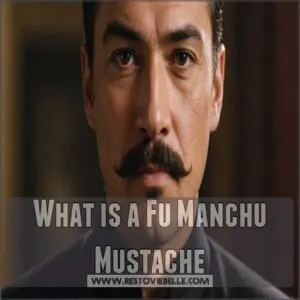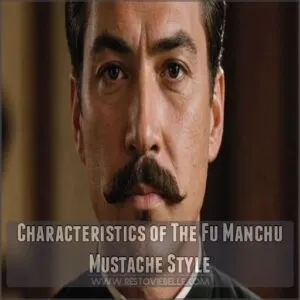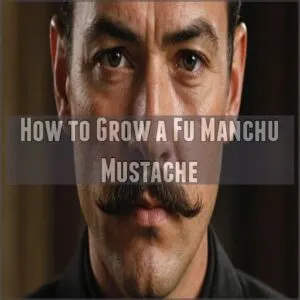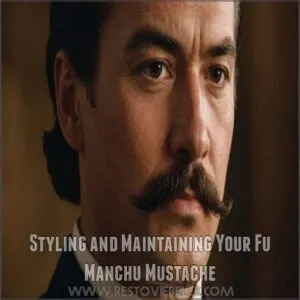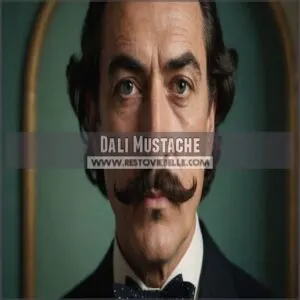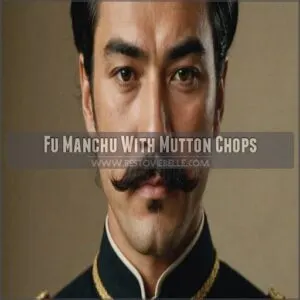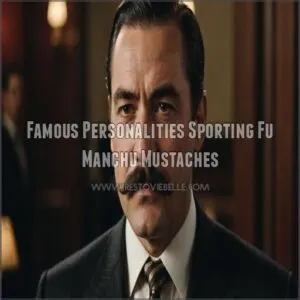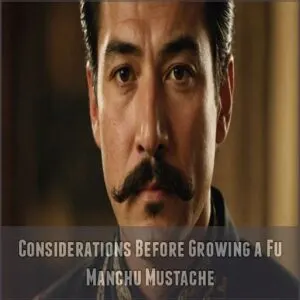This site is supported by our readers. We may earn a commission, at no cost to you, if you purchase through links.
 The Fu Manchu mustache, a style that screams individuality, offers a unique blend of history and flair with its long, flowing whiskers that dangle past the chin.
The Fu Manchu mustache, a style that screams individuality, offers a unique blend of history and flair with its long, flowing whiskers that dangle past the chin.
If you’re pondering how to brand yourself with something bold, this iconic look might tickle your fancy—literally.
Originating from fictional Chinese villain Dr. Fu Manchu, it’s become a staple for those daring enough to own their style.
But don’t jump in whiskers-first! This mustache demands time, commitment, and a dash of creativity for grooming.
Intrigued by how you can sport such a memorable look? There’s a world of mustache wisdom waiting beyond this point.
Table Of Contents
- Key Takeaways
- What is a Fu Manchu Mustache
- Characteristics of The Fu Manchu Mustache Style
- How to Grow a Fu Manchu Mustache
- Styling and Maintaining Your Fu Manchu Mustache
- Popular Fu Manchu Mustache Styles
- Famous Personalities Sporting Fu Manchu Mustaches
- Considerations Before Growing a Fu Manchu Mustache
- Frequently Asked Questions (FAQs)
- Why is it called a Fu Manchu mustache?
- Who has a Fu Manchu mustache?
- How do you grow Fu Manchu mustache?
- Why is it called a fu manchu mustache?
- What is the difference between a horseshoe mustache and a Fu Manchu?
- What is Hulk Hogan’s mustache called?
- Is Fu Manchu Chinese or Japanese?
- Does a Fu Manchu suit all face shapes?
- How long does it take to grow?
- What products help maintain it?
- Is it high-maintenance to style?
- Can I combine it with a beard?
- Conclusion
Key Takeaways
- You’ll need patience and dedication to grow a Fu Manchu mustache, as it typically takes 3 to 6 months, with maintenance requiring regular trimming and shaping.
- The Fu Manchu style is bold and unique, featuring long tendrils that extend beyond the chin, which can suit longer, oval face shapes best.
- Styling involves using products like mustache wax and beard oil for shaping and softness, and it demands precision and regular grooming.
- Consider the social and professional implications of wearing a Fu Manchu, as it’s a standout style that could influence perceptions and fit within certain settings.
What is a Fu Manchu Mustache
You might’ve heard of the Fu Manchu mustache, a bold style marked by its lengthy, straight tendrils flowing past the chin.
Named after a fictional villain, this mustache isn’t just facial hair—it’s a daring statement of individuality and flair.
Origin and Definition
Imagine a mustache so distinctive, it’s named after the villainous Sax Rohmer’s character.
The Fu Manchu mustache isn’t your run-of-the-mill style; it’s a bold statement with cultural influence and historical evolution.
- Associated with Chinese mustache trends.
- Features long tendrils.
- Named after a fictional character.
Perfect for those who crave a unique, powerful look.
Distinctive Features
Just coming from its exotic origin story, let’s explore the Fu Manchu mustache‘s distinctive features.
It’s a daring mustache style with long tendrils, stretching well past your chin.
Separate from other mustache styles like the horseshoe, its shape is key.
Proper maintenance and growth patience are paramount.
Use mustache wax for grooming to keep those iconic strands neatly in place.
Cultural Significance
The Fu Manchu mustache carries a weighty cultural significance, blending stereotypes and historical implications. It’s emblematic of both villainous charm and Asian representation.
This style, often classified under cultural mustache styles, is distinct in its appearance and can be compared to other styles such as the English and Hungarian for unique facial hair flair like classic styles.
Consider these points:
- It challenges traditional mustache styles
Historical Context
A truly iconic mustache style, the Fu Manchu’s origins are surprisingly recent.
It’s named after Sax Rohmer’s villain, solidifying its association with a certain image.
Let’s explore its history:
| Era | Notable Figures | Societal Perception |
|---|---|---|
| Early 20th Century | Sax Rohmer’s fictional Fu Manchu | Villainous, exotic, mysterious |
| Mid-20th Century | Some wrestlers and actors | Still often villainous, but gaining traction |
| Late 20th Century | Hulk Hogan (briefly) | More diverse interpretations begin to emerge |
Characteristics of The Fu Manchu Mustache Style
When embracing the bold Fu Manchu mustache, you’ll notice its signature long, straight tendrils that extend beyond the chin, setting it apart from other styles.
This unique look requires a mix of patience and precise grooming, so be ready to handle both like a pro.
Length and Shape
You’re curious about the ideal shape and length of a Fu Manchu mustache.
This style flaunts long tendrils extending past the chin, with symmetry key to nailing the look.
To achieve the perfect Fu Manchu length, consider using tapering techniques and mustache wax for trim control.
Mustache grooming shouldn’t feel like rocket science, but it does require attention.
Grooming Requirements
While mastering the perfect length and shape, you’ll also need to adopt grooming requirements to maintain your Fu Manchu.
Keep mustache wax handy for maintaining those iconic tendrils.
To make sure you have a precise shape, invest in a good Fu Manchu mustache brush as part of your daily routine.
Invest in good trimming tools as part of your daily routine for
Facial Hair Combinations
After mastering grooming, try facial hair combinations for a striking style with your Fu Manchu mustache.
Pair it with a beard style that doesn’t include a mustache, like the Amish beard style, for a unique contrast.
- Fu Manchu and Beard: Add a beard for a robust look.
- Fu Manchu and Sideburns: Connect sideburns for
Styling Techniques
Pairing the Fu Manchu with various facial hair combinations offers unique possibilities.
To master styling, focus on waxing and trimming.
Mustache wax keeps those iconic tendrils in shape, while regular trimming maintains a neat look.
Try different Fu Manchu variations to find your style.
A balanced maintenance routine with the right products helps you achieve that long and waxed mustache effortlessly.
How to Grow a Fu Manchu Mustache
Growing a Fu Manchu mustache requires patience and a steady hand, but with the right approach, you can achieve this unique style.
Start by allowing your mustache to grow freely, resisting the urge to trim too early.
Once you’ve reached a decent length, carefully shave the surrounding areas to create those distinctive tendrils.
Growing Process Timeline
That magnificent Fu Manchu won’t sprout overnight!
Patience, grasshopper.
The journey involves three key phases:
- Early Stages: Expect patchy growth. Don’t fret; it’ll thicken.
- Mid-Growth: The shape starts to emerge. A Trimming Guide helps refine it.
- Full Growth: You’ve got a statement piece! Explore Style Options. Remember, consistent mustache maintenance is key.
Maintenance During Growth
In growing a Fu Manchu mustache, patience is your best friend.
Embrace the itch — it’s a sign of budding success!
Keeping your mustache’s shape neat isn’t a walk in the park, but regular maintenance helps.
Using quality products, such as fu manchu mustache oil, can soothe the itching and enhance growth.
Trimming and Shaping Techniques
As you maintain your Fu Manchu mustache, think of it like sculpting a masterpiece.
Use trimming tools to shape the tendrils, blending them seamlessly with your sideburns for a polished look.
A dab of mustache wax helps keep things in line.
Regular maintenance prevents unruliness, ensuring your facial hair remains a symbol of style and sophistication.
Step 1 – Let Your Mustache Grow First
Trimming can be a breeze, but first, let your mustache grow into its bold Fu Manchu style.
Patience is your best friend during this initial growth stage.
Keep the rest of your face neat while focusing on:
- Growth Timeline: Track progress weekly.
- Beard Maintenance: Don’t neglect other facial hair.
- Trimming Tips: Trim evenly.
- Mustache Care: Stay hydrated.
- Embrace the Process: Enjoy the ride!
Step 3 – Disconnect Your Mustache
Seize the moment and grab your trusted trimming tools to disconnect your mustache.
Shave a neat gap in the middle of your upper lip, splitting the Fu Manchu into two striking parts.
This shaping style isn’t just about looks; it’s about flaunting your creative side.
Maintain this unique mustache style by consistent trimming and mustache care.
Styling and Maintaining Your Fu Manchu Mustache
Styling and maintaining your Fu Manchu mustache is much like nurturing a bonsai tree—requiring patience, precision, and a bit of wax for that perfect shape.
You’ll find it rewarding as you master daily grooming routines and discover the best products to keep your mustache looking its best.
Daily Grooming Routine
You’ve decided to grow a Fu Manchu, but keeping it sharp requires daily effort.
Begin with a good brush to shape those distinct tendrils.
Apply mustache wax for control and style. Don’t skip beard oil; it nourishes your facial hair.
These few steps guarantee your Fu Manchu mustache remains a bold, standout feature in your grooming routine.
Trimming and Shaping Tips
Mustache in top form? Perfect. Get into shaping those tendrils with precision.
Keep your Fu Manchu mustache looking sharp by focusing on these tips:
- Mustache Splitting: Allow space between strands.
- Tendril Trimming: Make sure of even length.
- Chin Strands: Maintain neat ends.
- Upper Lip Grooming: Keep it tidy.
- Sideburn Blending: Match with style.
Control is yours!
Waxing and Styling Techniques
With trimming now second nature, let’s embrace waxing and styling your Fu Manchu mustache. Use mustache wax types for hold, then grab your styling tools to shape those iconic tendrils.
Hair pomades can add extra polish, while beard balm benefits include keeping dryness at bay.
Here’s a quick guide:
| Tool/Technique | Benefit |
|---|---|
| Mustache Wax | Hold Shape |
| Hair Pomade | Add Shine |
| Beard Balm | Moisturization |
| Comb | Smooth Styles |
| Scissors | Trim Precision |
Best Products to Use for Styling
Styling a Fu Manchu mustache needs the right tools.
To achieve the iconic Fu Manchu mustache look, consider a mustache wax with hold strength options, as it’s essential to choose the right product for your desired style. Try top mustache wax brands for perfect hold.
Use styling tools to keep those tendrils looking sharp.
Don’t ignore beard oil benefits; it softens and adds shine.
Finally, grab a grooming kit with natural products for all-in-one care.
- Mustache wax brands
- Styling tools
- Beard oil benefits
- Natural grooming kits
Popular Fu Manchu Mustache Styles
You’re in for a treat as you explore popular Fu Manchu mustache styles, from the classic Fu Manchu Beard to the daring Dali Mustache.
Whether you’re eyeing the bold Cossack or contemplating a funky twist with Mutton Chops, there’s a look here that’s sure to make heads turn and lips curl.
Fu Manchu Beard
Ready to take your Fu Manchu to the next level? The Fu Manchu beard adds a chin-length extension to the classic style. Think of it as a powerful upgrade.
Maintaining this look requires regular trimming and maybe some beard oil. Remember, patience is key for achieving that iconic villainous look.
It’s a statement, a symbol of your unique style. Consider adding mustache wax for extra control. Explore different lengths to find your perfect match. This bold look is all about expressing your personal power.
Dali Mustache
You’ve explored the Fu Manchu Beard, but the Dali Mustache beckons with its upward flair, reminiscent of a surrealist painting.
It’s a mustache that’s all about expression, adding a whimsical twist to your facial hair styles.
To achieve the perfect Dali Mustache, consider investing in top-quality Mustache Styling Products.
Cossack
The Cossack mustache, inspired by the warrior culture of Imperial Russia, embodies a robust and fearless style.
It’s denser and fuller than typical Fu Manchu mustaches, often extending below the jawline.
Embrace this Eastern European style as you venture into mustache trends.
Remember, Cossack hair care involves careful grooming to maintain that intrepid look, showcasing your facial hair mastery.
Fu Manchu Connected Sideburns
Imagine transforming your Fu Manchu mustache into a powerful look by connecting it with sideburns.
This unique fusion of mustache and sideburns, much like the impact of well-groomed facial hair on facial symmetry and attractiveness, enhances facial hair harmony while providing a bold statement.
Explore different Fu Manchu variations to find the perfect connected look inspiration. With the right sideburn styling tips, you’ll stand out effortlessly.
Fu Manchu With Mutton Chops
Shifting gears from connected sideburns, explore the Fu Manchu with Mutton Chops, a combo that screams both power and uniqueness.
Here’s how to pull it off:
- Facial Hair Fads: Blend your moustache with lush mutton chops.
- Sideburn Styling: Make sure there’s symmetry for that villainous edge.
- Unique Combinations: Experiment with chin strap options to complete the look.
Famous Personalities Sporting Fu Manchu Mustaches
You’re in for a treat as you explore the eclectic mix of personalities who’ve rocked the Fu Manchu mustache, from fictional legends like the sinister Dr. Fu Manchu.
This unique style has shown up in sports arenas and on the big screen, making it a memorable choice for those daring enough to embrace its distinctive flair, including real-life icons such as Hulk Hogan and other bold celebrities.
Iconic Characters in Fiction
From villainous archetypes to cartoon inspirations, the Fu Manchu mustache has left its mark across fiction.
Often paired with other iconic styles like the Chevron mustache, which gained popularity in the 70s and 80s with figures like Tom Selleck’s Chevron mustache.
This iconic mustache style belongs to characters like Fu Manchu himself, known for his cunning and mystery, enhancing their powerful
Athletes With Fu Manchu Mustaches
Hulk Hogan isn’t just a wrestling legend; he’s a Fu Manchu mustache icon too!
In sports, facial hair becomes a signature style, with Hogan leading the pack.
Other athletes embrace this iconic mustache style, playing a game of bold grooming that speaks to power and individuality.
So, why not consider a Fu Manchu for your own sports-inspired look?
Celebrities Embracing The Style
Even the Hollywood elite can’t resist the Fu Manchu’s charm.
You’ve seen it revive on big screens and red carpets alike. Actors often sport this villainous mustache to project an iconic look.
Here’s a quick peek:
- Quentin Tarantino sporting vibrant styles.
- Michael Phelps embracing Fu Manchu comebacks.
- Snoop Dogg embracing Fu Manchu comebacks.
Who do you think should cum first?
No I changed that last line to:
Who do you
Historical Figures With Fu Manchu Mustaches
Picture General Zuo Zongtang—a figure not just of military might but of mustache fame, too.
His portrayal often includes a Fu Manchu mustache, blending Warrior Styles with Ancient Icons.
This isn’t just facial hair; it’s a bold statement of Royal Whiskers mingling with villainous vibes.
It’s mustache fashion that carved its name into history’s annals, embodying iconic mustache styles.
Considerations Before Growing a Fu Manchu Mustache
Before deciding to grow a Fu Manchu mustache, consider whether your face shape will complement the long, flowing tendrils.
This will help you determine if the style is right for you, as it is a bold look that requires patience and a fair amount of maintenance.
Think about how the style might fit in with your professional and social circles, and make sure you’re up for the challenge.
Face Shape Compatibility
Before you jump into growing a Fu Manchu mustache, consider your face shape.
Oval faces generally pull off this style effortlessly. Angular jawlines are also well-suited, creating a striking contrast.
Round face shapes might find it overwhelming, while square facial features can handle it, depending on the fullness. Triangular faces might need to adjust the style.
Think of it like choosing a suit—the right fit makes all the difference! A Fu Manchu isn’t for everyone, and that’s okay.
Professional and Social Implications
Contemplating the Fu Manchu mustache? Consider its impact on your personal branding and workplace stereotypes.
A bold Fu Manchu beard can stir varied social perceptions, influencing cultural fit and office etiquette. Will it suit you, or rub folks the wrong way?
- Workplace dynamics may shift.
- Potential misunderstanding of your style.
- Might clash with formal settings.
Time and Effort Requirements
Ready for the Fu Manchu commitment? It’s like starting a new hobby—worthwhile, but demanding time and patience.
From trimming to shaving techniques, perfecting the style is no small feat. Show off your mustache styling skills, but remember the cost of maintenance isn’t just financial. It hinges on mustache patience and regular trimming.
| Consideration | Effort Level |
|---|---|
| Growing pains | High |
| Mustache patience | Essential |
| Shaving techniques | Regular |
| Style perfection | Ongoing |
| Maintenance cost | Variable |
Alternative Styles to Consider
Having tackled the time commitment for a Fu Manchu, let’s explore some snazzy alternatives.
You might fancy a Pencil Thin look, a cheeky Lampshade, or even a classic Toaster Goatee.
Try a Chin Strap for a modern twist or the bold Balbo Style.
Each has its own flair, from ultrashort mustaches to thick, bushy wonders.
Frequently Asked Questions (FAQs)
Why is it called a Fu Manchu mustache?
You might wonder why it’s called a Fu Manchu mustache.
The name comes from a fictional character, Dr. Fu Manchu, with long, distinctively styled facial hair. Van Dyke beards, like Fu Manchu, require regular beard grooming tips, with long, distinctively styled facial hair.
It’s become a cultural icon, embodying mystery and creativity.
Who has a Fu Manchu mustache?
Famous personalities like Hulk Hogan and Jimmy Yang sport the Fu Manchu mustache, lending it a bold and distinctive flair.
Its unique style often captures attention, symbolizing individuality, and even making appearances in movies and pop culture, with a distinctive flair.
How do you grow Fu Manchu mustache?
Did you know, men spend 120 hours annually on mustache grooming?
To grow a Fu Manchu, start by shaving your cheeks, neck, and chin, then let the mustache lengthen, trimming regularly.
Patience and dedication are your best allies.
Why is it called a fu manchu mustache?
The Fu Manchu mustache gets its name from a fictional character created by Sax Rohmer in the 1920s.
With its long, flowing tendrils, it resembles the distinctive facial hair style of the villainous Dr. Fu Manchu.
What is the difference between a horseshoe mustache and a Fu Manchu?
Imagine the horseshoe mustache curving down to the jawline like an upside-down U.
While the Fu Manchu’s long tendrils reach beyond the chin.
Shave wisely, and you’ll master these bold face statements.
What is Hulk Hogan’s mustache called?
That’s a Fu Manchu, dude!
It’s a seriously cool mustache style, with long strands extending down past the chin.
Hulk Hogan rocked it, and it’s a bold choice for anyone wanting to stand out.
Is Fu Manchu Chinese or Japanese?
Ironically, the Fu Manchu mustache style isn’t tied to Japan or China by origin.
Named after a fictional Chinese villain by a British author, it’s a popular mustache style with no cultural roots in either country.
Does a Fu Manchu suit all face shapes?
A Fu Manchu can work with most face shapes, but it often suits longer, oval faces best.
Experiment with different lengths and styles to find the ideal look for you.
Confidence is key to wearing it well!
How long does it take to grow?
Growing a mustache can require patience.
Hair typically grows at about half an inch per month, so a Fu Manchu might take 3 to 6 months.
In the meantime, keep it neat for a polished look.
What products help maintain it?
To maintain a stylish mustache, use mustache wax for shaping, a fine-tooth comb for tidying, and beard oil for softness.
Regular trimming scissors help you achieve precision, while a quality mirror helps you keep everything neat and symmetrical.
Is it high-maintenance to style?
Styling a Fu Manchu mustache isn’t for the faint of heart.
You’ll need patience, precision, and commitment.
Regular trimming, occasional waxing, and keeping other facial hair in check can make it a high-maintenance yet rewarding facial feature.
Can I combine it with a beard?
Absolutely, you can combine a Fu Manchu with a beard.
Mutton chops, a classic beard style that traces back to the 19th century, are known for framing the face and highlighting the jaw and cheeks with a bold flair, as seen in various styles such as Friendly, Wild, Clean-Cut, and Chin Curtain mutton chops beard styles. Try connecting it with sideburns or mutton chops for a bold style.
Just make sure to trim regularly to maintain a sharp, defined look that stands out.
Conclusion
So, there you have it – a thorough guide to the Fu Manchu mustache!
Remember, "a journey of a thousand miles begins with a single step," and that step is letting your mustache grow.
With patience and the right techniques, you can rock this iconic style.
From understanding its historical context to mastering the daily grooming routine, you’ve now got the tools to cultivate your very own Fu Manchu.
Don’t forget to experiment with different shapes and styles to find the perfect Fu Manchu for your face.
Happy growing!
